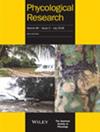Characteristics of maltose transport system in the endosymbiont Chlorella variabilis of Paramecium bursaria
IF 1
4区 生物学
Q2 MARINE & FRESHWATER BIOLOGY
引用次数: 0
Abstract
Paramecium bursaria has hundreds of chlorella in the cell. These symbiotic chlorella cells supply maltose, a photosynthetic product, to the host. Only symbiotic chlorella retains the ability to release maltose to the extracellular space, whereas free‐living chlorella does not. To provide the host with maltose, a maltose transporter localized on the symbiotic chlorella plasma membrane is required. However, the molecular identity of the maltose transporter and its properties are unknown. To better understand the characteristics of the maltose transporter, we investigated how maltose release by Chlorella variabilis is affected by the excess external maltose and several agents that inhibit ATP synthesis or disrupt the ion gradient across cell membranes. Our overall findings, including the observation that C. variabilis did not utilize maltose in the growth medium, led to the conclusion that the maltose transporter is likely a unidirectional and active transporter, which utilizes a proton gradient across the plasma membrane and does not use ATP as its energy source.法氏草履虫内共生变异小球藻麦芽糖转运系统的特性
法氏草履虫的细胞中有数百个小球藻。这些共生的小球藻细胞为宿主提供麦芽糖,一种光合产物。只有共生小球藻保留了将麦芽糖释放到细胞外空间的能力,而自由生活的小球藻则没有。为了向宿主提供麦芽糖,需要定位在共生小球藻质膜上的麦芽糖转运体。然而,麦芽糖转运体的分子特性及其性质尚不清楚。为了更好地了解麦芽糖转运体的特性,我们研究了过量的外部麦芽糖和几种抑制ATP合成或破坏细胞膜离子梯度的药物是如何影响变异小球藻释放麦芽糖的。我们的总体研究结果,包括观察到变胞杆菌在生长培养基中不利用麦芽糖,得出结论麦芽糖转运体可能是一种单向的主动转运体,它利用质子梯度穿过质膜,不使用ATP作为其能量来源。
本文章由计算机程序翻译,如有差异,请以英文原文为准。
求助全文
约1分钟内获得全文
求助全文
来源期刊

Phycological Research
生物-海洋与淡水生物学
CiteScore
3.60
自引率
13.30%
发文量
33
审稿时长
>12 weeks
期刊介绍:
Phycological Research is published by the Japanese Society of Phycology and complements the Japanese Journal of Phycology. The Journal publishes international, basic or applied, peer-reviewed research dealing with all aspects of phycology including ecology, taxonomy and phylogeny, evolution, genetics, molecular biology, biochemistry, cell biology, morphology, physiology, new techniques to facilitate the international exchange of results. All articles are peer-reviewed by at least two researchers expert in the filed of the submitted paper. Phycological Research has been credited by the International Association for Plant Taxonomy for the purpose of registration of new non-vascular plant names (including fossils).
 求助内容:
求助内容: 应助结果提醒方式:
应助结果提醒方式:


